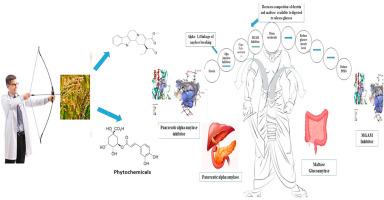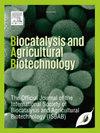From millets to medicine: ADMET insights into diabetes management with P. sumatrense compounds
IF 3.4
Q2 BIOTECHNOLOGY & APPLIED MICROBIOLOGY
引用次数: 0
Abstract
Diabetes mellitus, a prevalent metabolic disorder characterised by impaired blood glucose regulation, has escalated into a global health crisis, exacerbated by high-glycaemic diets and unhealthy eating habits. While therapeutic agents such as acarbose mitigate diabetes by inhibiting alpha-amylase and alpha-glucosidase, their use is marred by adverse side effects, underscoring the need for safer, plant-based alternatives. This study explores the antidiabetic potential of Little Millet, an underutilised cereal grain with a low glycaemic index, rich in bioactive compounds. Unlike common staples such as wheat and rice, Little Millet contains unique compounds, including octodrine, 18,19-secoyohimban-19-oic acid, and phenylephrine, which were investigated for their novel application in diabetes management. Gas chromatography-mass spectrometry (GCMS) analysis identified 120 bioactive compounds, selected for their abundance and potential bioactivity. These compounds span fatty acids, phenols, flavonoids, organic acids, sugar alcohols, and amino acids, all of which were rigorously docked to alpha-amylase and human maltase-glucoamylase receptors. Notably, key ligands such as chlorogenic acid and 18,19-secoyohimban-19-oic acid exhibited superior binding affinities compared to acarbose, with promising drug-likeness and ADMET profiles, suggesting higher absorption and fewer side effects. A 100-ns dynamics simulation further validated the stability of these compounds, positioning them as viable candidates for diabetes treatment. These findings advance drug design and highlight the potential of incorporating Little Millet into diets for diabetes prevention. Further validation through In-vitro, In-vivo, and clinical studies is essential to fully realise their therapeutic potential. This research also opens avenues for exploring Little Millet in managing related conditions and enhancing its health benefits through breeding programmes.

从黍到药:苏马特伦草化合物的 ADMET 对糖尿病管理的启示
糖尿病是一种以血糖调节功能受损为特征的流行性代谢紊乱疾病,由于高血糖饮食和不健康的饮食习惯而加剧,已升级为全球健康危机。虽然阿卡波糖等治疗药物通过抑制α-淀粉酶和α-葡萄糖苷酶来缓解糖尿病,但它们的使用受到不良副作用的影响,这突出表明需要更安全的植物替代品。这项研究探索了小米的抗糖尿病潜力,小米是一种未被充分利用的谷物,血糖指数低,富含生物活性化合物。与小麦和大米等常见主食不同,小米含有独特的化合物,包括辛辣素、18,19-仲酰基-19-辛-酸和苯肾上腺素,本研究对这些化合物在糖尿病治疗中的新应用进行了研究。气相色谱-质谱(GCMS)分析确定了 120 种生物活性化合物,这些化合物是根据其丰度和潜在生物活性筛选出来的。这些化合物包括脂肪酸、酚类、黄酮类、有机酸、糖醇和氨基酸,所有这些化合物都与α-淀粉酶和人类麦芽糖酶-葡萄糖淀粉酶受体进行了严格的对接。值得注意的是,与阿卡波糖相比,绿原酸和 18,19-仲酰基辛烷-19-酸等关键配体表现出更优越的结合亲和力,同时具有良好的药物相似性和 ADMET 特征,表明吸收率更高,副作用更少。100-ns 动力学模拟进一步验证了这些化合物的稳定性,使它们成为治疗糖尿病的可行候选药物。这些发现推动了药物设计的发展,并凸显了将小米纳入饮食以预防糖尿病的潜力。通过体外、体内和临床研究进行进一步验证对于充分发挥其治疗潜力至关重要。这项研究还为通过育种计划探索小米在管理相关疾病和提高其健康益处方面开辟了道路。
本文章由计算机程序翻译,如有差异,请以英文原文为准。
求助全文
约1分钟内获得全文
求助全文
来源期刊

Biocatalysis and agricultural biotechnology
Agricultural and Biological Sciences-Agronomy and Crop Science
CiteScore
7.70
自引率
2.50%
发文量
308
审稿时长
48 days
期刊介绍:
Biocatalysis and Agricultural Biotechnology is the official journal of the International Society of Biocatalysis and Agricultural Biotechnology (ISBAB). The journal publishes high quality articles especially in the science and technology of biocatalysis, bioprocesses, agricultural biotechnology, biomedical biotechnology, and, if appropriate, from other related areas of biotechnology. The journal will publish peer-reviewed basic and applied research papers, authoritative reviews, and feature articles. The scope of the journal encompasses the research, industrial, and commercial aspects of biotechnology, including the areas of: biocatalysis; bioprocesses; food and agriculture; genetic engineering; molecular biology; healthcare and pharmaceuticals; biofuels; genomics; nanotechnology; environment and biodiversity; and bioremediation.
 求助内容:
求助内容: 应助结果提醒方式:
应助结果提醒方式:


